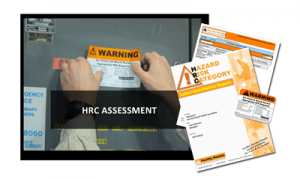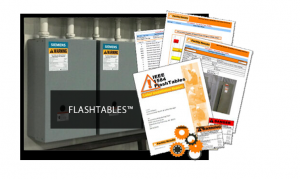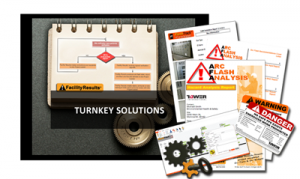Arc Flash Compliance Overview - Electrical Safety & Label Compliance
Arc Flash Study and Compliance Services
Staying up-to-date with arc flash study compliance standards may seem like a constant job in itself. While you may consider falling behind with the latest NFPA 70E training requirements, consider the risks. There are fines, hazards, and even the possible loss of life if you don’t keep your staff up to date. Why should you risk it?
This is where Facility Results’ four-pronged approach comes in. Our services can provide you the latest arc flash training and NFPA 70E training all within your budget and fit your business. Our expert instructors can show you and your team not only how they can apply new standards to their work, but also efficient ways to complete Facility Results Written Safety Program. Safety should be your number one concern and staying up to the industry standards is the easiest way to do so. It’s easy to stay safe with arc flash training from Facility Results! Learn more about our programs and arc flash data collection compliance services below:

Arc Flash Compliance –
Hazard/Risk Category (HRC) Assessment
Contract with Facility Results to provide the resources for a table-based alternative to a costly electrically engineered compliance solution.

Arc Flash Analysis –
FlashTables™ based on IEEE 1584
FlashTables™ is a Licensed Intellectual Product that Facility Results can install for 1/3 of the cost of other methods. FlashTables™ is ideal for dynamically changing facilities, and the intent is to label all electrical panels on the plant floor. The average manufacturing facility requires 500 labels and can be OSHA-compliant in one week or less.

Arc Flash Compliance –
Engineer-Assisted Incident Energy Analysis:
Using your internal resources, partner with Facility Results to use FlashTrack™—the #1 arc flash data collection software tool on the market. Then, forward the data you collect to Facility Results for completing an engineer-assisted energy analysis, including comprehensive one-line reports and all required labels.
 Arc Flash Compliance –
Arc Flash Compliance –
Turnkey Incident Energy Analysis:
Don’t have the standards knowledge or the people to roll out a full compliance analysis? From top to bottom, Facility Results can provide the people, the tools, and the expertise to perform a comprehensive incident energy analysis, including a model of your power distribution system and a complete, written compliance program.
Arc flash study based on IEEE 1584 vs. NFPA 70E Tables 130.7, What is better?
 Arc flash analysis (or study) is used to evaluate an electrical system’s potential hazards and determine the appropriate personal protective equipment (PPE) and safety procedures for workers exposed to those hazards. Several methods and standards exist for arc flash analysis, including the IEEE 1584 and NFPA 70E Tables 130.7.
Arc flash analysis (or study) is used to evaluate an electrical system’s potential hazards and determine the appropriate personal protective equipment (PPE) and safety procedures for workers exposed to those hazards. Several methods and standards exist for arc flash analysis, including the IEEE 1584 and NFPA 70E Tables 130.7.
IEEE 1584 is a guide for arc flash hazard calculations developed by the Institute of Electrical and Electronics Engineers (IEEE). It provides a methodology for determining the incident energy at a working distance of 18 inches (45 cm) from the arc and the PPE required to protect workers from that energy. The methodology involves calculating the arc flash energy based on the available short-circuit current, the protective device opening time, the system voltage, and other electrical and mechanical factors.
NFPA 70E, on the other hand, is a standard developed by the National Fire Protection Association (NFPA) that provides guidelines for electrical safety in the workplace. It includes Table 130.7, which provides recommended PPE levels based on the incident energy calculated using the IEEE 1584 or other approved methods. The table includes four levels of PPE, ranging from Level 0 (minimal risk) to Level 4 (maximum risk).
The IEEE 1584 and NFPA 70E Table 130.7 are widely used for arc flash analysis and are considered reliable methods. However, there are some differences between the two approaches.
One difference is that the IEEE 1584 method is based on calculations, whereas the NFPA 70E Table 130.7 is based on tables of recommended PPE levels. This means that the IEEE 1584 method is more precise in determining the specific incident energy and required PPE, while the NFPA 70E Table 130.7 provides more general guidance.
Another difference is that the IEEE 1584 method is based on a working distance of 18 inches, while the NFPA 70E Table 130.7 is based on a working distance of 0 inches (i.e., contact with the arc). The IEEE 1584 method may result in lower incident energy levels and less stringent PPE requirements than the NFPA 70E Table 130.7.
It is important to note that the IEEE 1584 and NFPA 70E Table 130.7 are only guidelines. The actual arc flash hazards and required PPE may vary depending on the specific electrical system and working conditions. It is recommended to consult with a qualified electrical engineer or other qualified professionals to determine the appropriate arc flash analysis method and PPE for a particular situation.
In summary, both the IEEE 1584 and NFPA 70E Table 130.7 are useful methods for performing arc flash analysis. Still, they differ regarding the specific calculations and recommended PPE levels. It is essential to use the appropriate method and follow the recommended guidelines to ensure the safety of workers exposed to arc flash hazards.
What Is An Arc Flash Study – Short Circuit Analysis Explained
An arc flash study, also known as short circuit analysis, is used to identify the potential electrical hazards associated with a particular electrical system and determine the necessary protective measures to prevent injury or damage. The study analyzes the electrical system to determine the available short circuit current, the fault current at different points in the system, and the protective device clearing times.
The purpose of an arc flash study is to determine the arc flash hazard potential of a facility’s electrical system, which is the potential for an electrical arc to occur and release a large amount of energy. This energy can cause serious injury or death to personnel and damage to equipment. The study helps facility managers and electrical engineers identify areas of the electrical system that may be at risk for an arc flash and take steps to mitigate those risks.
To perform an arc flash study, engineers typically use specialized software to model the electrical system and analyze the various components and their interactions. The study includes a detailed analysis of the electrical equipment and its ratings, the electrical protective devices and their characteristics, and the available fault current at different points in the system. Based on this analysis, the engineer can determine the arc flash hazard level and recommend protective measures, such as the use of protective clothing or the installation of additional protective devices.
An arc flash study is an important part of electrical safety in any facility, and it is typically required by national and local electrical codes and standards. By identifying potential arc flash hazards and taking appropriate protective measures, facility managers can help ensure the safety of personnel and equipment and minimize the risk of electrical accidents.
What information is helpful on an arc flash label and considered a “Best Practice” NFPA 70E Arc Flash Label?
- The available incident energy at the working distance, measured in calories per centimeter squared (cal/cm^2). Or, The hazard/risk category (HRC) level is a numerical rating that reflects the severity of the arc flash hazard. The HRC levels range from 0 to 4, with N/A (or Less Than 1.2 cal/cm^2) being the lowest level of hazard and 4 being the highest.
- The required level of personal protective equipment (PPE) is based on the incident energy, including the arc rating of the clothing and any additional protective equipment such as face shields or flash suits.
- The nominal system voltage is the voltage at which the equipment is designed to operate.
- The arc flash boundary is the distance from the electrical equipment at which the incident energy equals 1.2 cal/cm^2. This is the distance at which a person would need to wear the minimum level of PPE (HRC Level 0).
- The limited approach boundary is the distance from the electrical equipment at which the incident energy is equal to the arc rating of the clothing being worn. This is the minimum distance a person can safely work on or near live electrical equipment.
- Any additional warning or caution statements, such as “Danger – High Voltage” or “Do Not Operate Without Proper PPE.”
- The name of the manufacturer or supplier of the equipment, as well as the date of manufacture or installation.
- The location and identification of the electrical equipment, including the panel or switchboard name and number and the circuit or equipment number.
- Any special instructions or precautions must be followed when working on or near the electrical equipment, such as de-energizing the equipment before starting work.
It is important to note that the information required on an arc flash label may vary depending on the specific electrical equipment and the work being performed. It is the responsibility of the employer to ensure that appropriate arc flash labels are affixed to all electrical equipment and that employees are trained on how to interpret and use the information on the labels with proper arc flash training that can be done on-site or online. The labels result from conducting an arc flash study or arc flash analysis.
